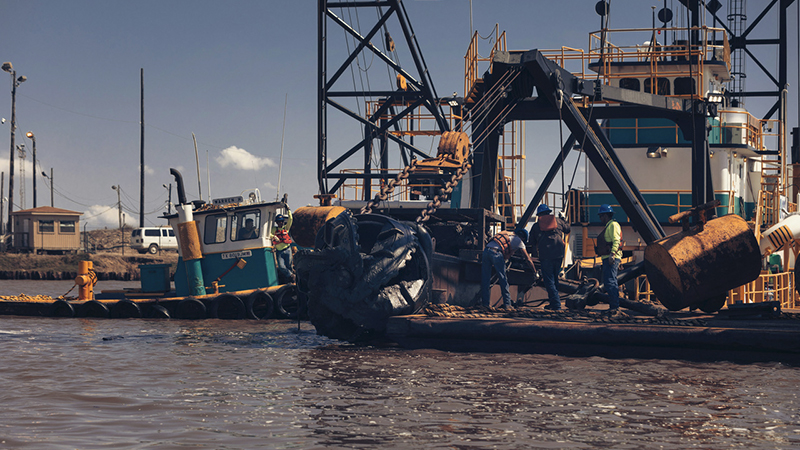Deeper waters, bigger ships: Agreement signed to begin work dredging Sabine Neches Waterway
Published 12:19 am Tuesday, July 30, 2019

- A dredger performs maintenance work on the Sabine-Neches Waterway near Texaco Island, in Port Arthur, Texas. (Courtesy photo)
The Sabine Neches Navigation District and the Army Corps of Engineers signed a Project Partnership Agreement Friday, giving the green light for the start of a project that will deepen the Sabine Neches Waterway from 40 feet to 48 feet.
The agreement was announced in a press release on Monday.
“We’ve gone through all the hurdles to get to this point, and we’re anticipating the groundbreaking to be in late September of this year,” Navigation District Public Affairs Manager Payton Keith said.
Trending
The project will cover dredging in the ship channel from just north of Total to the Port of Beaumont. The project will take place in phases, with the dredging of the turning basins coming first and the deepening of sections of the waterway split between two 4-feet excavations.

SNND Deputy Director Matthew Kaufman and Jefferson County Judge Jeff Branick watch as SNND Executive Director Randall Reese and USACE Galveston Commander Colonel Timothy Vail sign the Project Partnership Agreement (PPA) commencing the channel improvement project to deepen the Sabine-Neches Waterway from 40 feet to 48 feet. (Courtesy photo)
The work is expected to be complete within nine years.
The first round of federal funding for the project came in November with the passage of the Fiscal Year 2019 Work Plan Authorization. The project is estimated to cost $900 million.
Funding will be split between federal and local sources, with Washington providing 75 percent and the State of Texas providing 25 percent. Part of the local funding will come from the Navigation District sharing the dredging work.
“We’re not going to be writing the Army Corps of Engineers a check,” Navigation District Deputy Director Matthew Kaufman said. “We’re going to actually be doing all of the cost share as work-in-kind, so we’ll be using our own dredging contracts in tandem with the Corps of Engineers.”

SNND Executive Director Randall Reese smiles as he signs the Project Partnership Agreement with the US Army Corps of Engineers to begin construction on the deepening project. (Courtesy photo)
The nitty-gritty
Trending
The Navigation District currently uses dredging ships on a near constant basis to keep the waterway 40 feet deep, but even that maintenance isn’t enough to handle the largest volumes of cargo.
“Inbound or outbound, a fully loaded crude oil tanker cannot transit our waterway because it’s not deep enough,” Keith said. “So we have to send out another tanker or barge offshore to transfer some of the crude oil. We essentially have to make more transits with more vehicles to manage all of the product.”
Onlookers may not notice much of a change when the deepening project begins in late September.
“From the naked eye, before and after the project, you won’t be able to tell the difference,” Kaufman said. “You won’t know that the water way has been deepened.”
Nonetheless, the project is expected to dig up 90 million cubic yards of dirt. That material will be deposited into placement areas covering more than 11,000 acres all along the waterway for development for commercial or industrial projects.
“Overall we have a lot of real estate available, and that’s something that long term is going to benefit the area — more jobs, more investments, more economic benefits,” Keith said.
The Corps of Engineers and the Navigation District will use a pipeline dredging system, which employs a drill that breaks up and sucks up dirt into piping and transported to the surface, where it will be deposited at one of the Navigation District’s placement areas.
The bottom line
The Sabine Neches Waterway is the largest exporter of crude oil and liquefied natural gas in the nation and the third largest waterway in the nation by cargo tonnage. 158 million tons of cargo is shipped through the waterway annually, and, with the deepening of the channel, will increase to 210 million by 2026, according to information provided by the Navigation District.
The deepened waterway is also expected to add 336,000 new permanent jobs, $200 billion in business activity, $67 billion in gross product and $6 billion in state taxes.
“In the past 8 to 9 years, we’ve competed, started construction on, or proposed almost $77 billion in large scale industrial investment on our waterway. It’s a pretty staggering figure,” Keith said. “The Gulf Coast is booming, and we’re leading that charge in terms of overall investment.”





